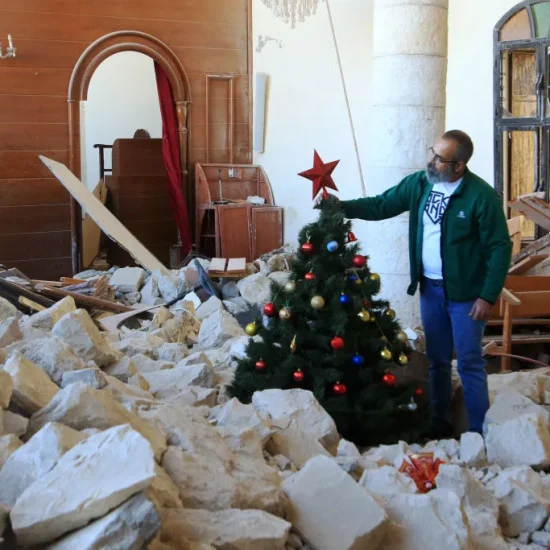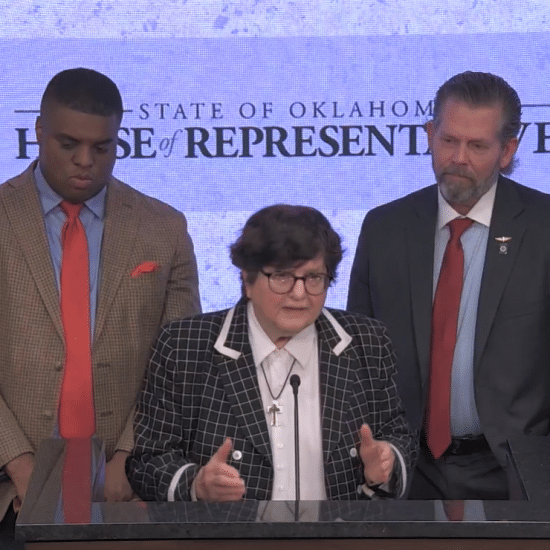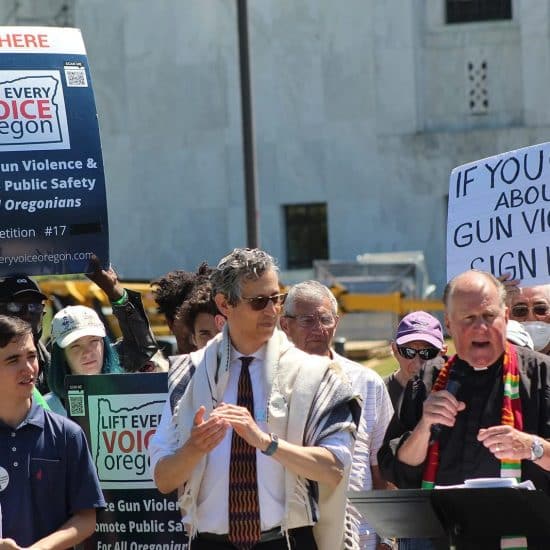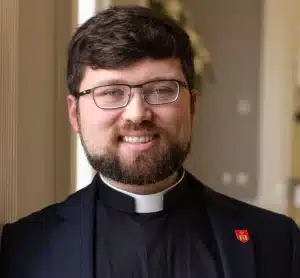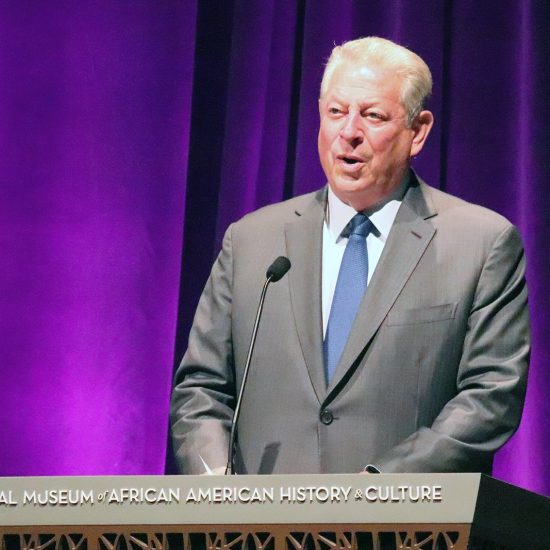BOLIVAR, Mo. — A chance statement four years ago has led to a broken heart, a purpose and a lifelong commitment to the Lakota people for Kurt Caddy and now for Southwest Baptist University students.

A Lakota child enjoys time on a tire swing. (Photo courtesy of Kurt Caddy)
|
The director of university ministries at SBU in Bolivar, Mo., “always had sort of an affinity” for Native Americans, he said. During one summer break while in college, he worked with the Eskimo in Alaska, and he put himself through seminary by creating Native American art.
One day about four years ago, he made a chance remark to his staff about his earlier connections and wondered aloud about life for Native Americans today. A staffer googled the topic and found “The Arrogance of Ignorance: Hidden Away, Out of Sight and Out of Mind” by Stephanie Schwartz, about conditions on the Pine Ridge Oglala Lakota (Sioux) Reservation in South Dakota.
As he read the article, Caddy said, “I was just stunned by the problems. I remember when putting it down, I said, ‘Lord, I need to be there.’”
Unable to get the Lakotas’ plight out of his mind and heart, Caddy traveled to Pine Ridge (one of seven Lakota reservations) about a year later to see the conditions himself.
An avid photographer, he had taken his camera along. “I had a burst of creativity that I hadn’t had in a long time,” he said.
God used the beauty and the misery to trigger that creative spurt. “The beauty and the pain were all close together. It is a hard place to do ministry but one of the most beautiful,” he said. “I found myself able to see things through the lens.”
Must tell their story
While the trip touched him deeply, he struggled with the realization that few outside the reservations were even aware of what has been happening. “When I came back, no one knew what I was talking about…. I felt overwhelmed that people didn’t know…about their [the Lakota] plight,” he said.

A photo team from Southwest Baptist University captures a glimpse of life among the Lakota on the Cheyenne River Reservation in South Dakota. (Photo courtesy of Kurt Caddy)
|
Caddy put together a display of Native American art, including his photographs from the trip. Then he invited David Johnson from Silent Images to speak in a chapel service. A not-for-profit, Silent Images recruits professional photographers to assist other nonprofits with “advocacy photography” to tell the stories of the voiceless or oppressed.
While listening to Johnson’s presentation, Caddy thought, “Wow, this is what needs to happen for the Lakota.”
Johnson suggested Caddy put together a photo team to tell the Lakota story. In the meantime, Caddy continued to head to South Dakota, taking student teams and his family with him on most of the nine trips he has made.
Last fall, he recruited a team of 13 students and two others, including Todd Walker, an SBU alum who had become a professional photographer, as a photo team. They met every week for 13 weeks beginning in January to learn about the Lakota and plan the project.
“About half of the people I talked to knew about Wounded Knee” [site of the last major U.S. military strike to subdue Native Americans on Dec. 29, 1890, and called the Wounded Knee Massacre], he explained. “There is a huge need to let people know about their history, their struggles and their ongoing struggle.”
The photo team spent from May 20-29 on the Cheyenne River Reservation, with their base at Cherry Creek. Most mission groups do not have the opportunity to stay on the Lakota reservations, instead sleeping elsewhere and returning for ministry each day.
Caddy connected with and is now partnering with Anthony Hanson, a Lakota and founder of New Hope Native American Mission in Cherry Creek.
Before the team could begin photographing the people and their daily life, members had to build trust with the community, Caddy explained. For about five days, team members did service projects, helping set up a community garden and presenting a seminar on growing and preserving produce.
They built a pavilion next to the cemetery as a place for the community to serve funeral meals. And they built 25 crosses for the cemetery to help replace those lost when a planned burn got out of control.
Then they took pictures — lots of them, Caddy said. About 5,000 that they are culling and editing and that will become the basis of two phases for getting the Lakotas’ story out.
They have targeted November for the release of Phase I, a display of photos that Caddy hopes to be able to share, not only at SBU, but also on other college campuses and in local churches.
Phase II will be producing and publishing a coffee-table book of photos, with the proceeds of book sales to benefit the Lakota.
Repairing damage
Getting their story told is important for a couple of reasons he said. First, in some ways Christians are still unraveling damage unintentionally done by early believers.
“The Lakota have had 500 years of missionary exposure. They have had access to the gospel…and have been exposed to the gospel…but still less than 2 percent are Christian…,” Caddy explained. “Right here in our own midst we have an unreached people group….
“But there has been some really bad missionary practice,” he added. He pointed out that the Lakota were forced to assimilate into European culture in many ways. They were forced to send their children to boarding school, and they were told not to speak their heart language.
The Lakota were among the tribes most able to sustain themselves because they lived off the land. As Europeans took over prime lands and the Lakota were forced onto small reservations, the Lakota became less able to take care of their needs. “Now they are some of the most dependent people,” Caddy said.
Ziebach County, part of Cheyenne River, is consistently first or second on the list of most impoverished counties in the United States. According to the U.S. Census Bureau, nearly 44 percent of the population lived below the poverty line in 2011.
He hopes to work with Hanson and New Hope’s board to “do more to help them be sustainable,” he said. The Lakota do “amazing” beadwork, but they have no Internet access from which to market their products.
Spread the gospel
Second, all people, including the Lakota, need to hear the gospel. Caddy said he always takes the teams he leads to Wounded Knee because he believes it is a “spiritual stronghold.”
But there is “an openness” right now at Cherry Creek, he said. “I would like to use it as a launching pad…a training center…to train the Lakota to reach their own people…. I hope it could become a place where a church planting movement would begin.”
As long as the Lord will allow, Caddy plans to continue making treks to South Dakota and taking students with him. The first few times he went to Cheyenne River, he repeatedly asked God if he was supposed to move to the region to minister.
“But I realized that what I’m supposed to do is working with the next generation of world changers,” Caddy said. “I felt very clearly…I’m supposed to be an advocate and spokesperson.”
To anyone who asks why he goes, Caddy always responds: “It’s a great place to go to have your heart broken.” One reason he has taken hundreds of students to Cheyenne River is to have their hearts broken enough to allow them to think about God’s purpose for them.
Most students who go are heartbroken, he said. When they query why they have “had it so good,” Caddy tells them they are not asking the right question.
“The question is: What are you going to do with your life, your possessions, your degree?”

